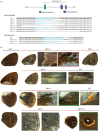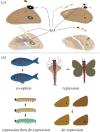apterous A specifies dorsal wing patterns and sexual traits in butterflies
- PMID: 29467265
- PMCID: PMC5832707
- DOI: 10.1098/rspb.2017.2685
apterous A specifies dorsal wing patterns and sexual traits in butterflies
Abstract
Butterflies have evolved different colour patterns on their dorsal and ventral wing surfaces to serve different signalling functions, yet the developmental mechanisms controlling surface-specific patterning are still unknown. Here, we mutate both copies of the transcription factor apterous in Bicyclus anynana butterflies using CRISPR/Cas9 and show that apterous A, expressed dorsally, functions both as a repressor and modifier of ventral wing colour patterns, as well as a promoter of dorsal sexual ornaments in males. We propose that the surface-specific diversification of wing patterns in butterflies proceeded via the co-option of apterous A or its downstream effectors into various gene regulatory networks involved in the differentiation of discrete wing traits. Further, interactions between apterous and sex-specific factors such as doublesex may have contributed to the origin of sexually dimorphic surface-specific patterns. Finally, we discuss the evolution of eyespot number diversity in the family Nymphalidae within the context of developmental constraints due to apterous regulation.
Keywords: apterous; butterfly wing patterns; developmental constraints; dorsal–ventral differentiation; eyespot repression.
© 2018 The Authors.
Conflict of interest statement
We declare we have no competing interests.
Figures




Similar articles
-
Male Bicyclus anynana Butterflies Choose Females on the Basis of Their Ventral UV-Reflective Eyespot Centers.J Insect Sci. 2019 Jan 1;19(1):25. doi: 10.1093/jisesa/iez014. J Insect Sci. 2019. PMID: 30794728 Free PMC article.
-
Cortex cis-regulatory switches establish scale colour identity and pattern diversity in Heliconius.Elife. 2021 Jul 19;10:e68549. doi: 10.7554/eLife.68549. Elife. 2021. PMID: 34280087 Free PMC article.
-
Origin, development, and evolution of butterfly eyespots.Annu Rev Entomol. 2015 Jan 7;60:253-71. doi: 10.1146/annurev-ento-010814-020942. Epub 2014 Oct 17. Annu Rev Entomol. 2015. PMID: 25341098 Review.
-
Wound healing, calcium signaling, and other novel pathways are associated with the formation of butterfly eyespots.BMC Genomics. 2017 Oct 16;18(1):788. doi: 10.1186/s12864-017-4175-7. BMC Genomics. 2017. PMID: 29037153 Free PMC article.
-
Waiting in the wings: what can we learn about gene co-option from the diversification of butterfly wing patterns?Philos Trans R Soc Lond B Biol Sci. 2017 Feb 5;372(1713):20150485. doi: 10.1098/rstb.2015.0485. Philos Trans R Soc Lond B Biol Sci. 2017. PMID: 27994126 Free PMC article. Review.
Cited by
-
Single-nucleus transcriptomics of wing sexual dimorphism and scale cell specialization in sulphur butterflies.PLoS Biol. 2025 Jun 18;23(6):e3003233. doi: 10.1371/journal.pbio.3003233. eCollection 2025 Jun. PLoS Biol. 2025. PMID: 40532028 Free PMC article.
-
Dissection of Larval and Pupal Wings of Bicyclus anynana Butterflies.Methods Protoc. 2020 Jan 10;3(1):5. doi: 10.3390/mps3010005. Methods Protoc. 2020. PMID: 31936719 Free PMC article.
-
Flight or protection: the genes Ultrabithorax and apterous in the determination of membranous and sclerotized wings in insects.Proc Biol Sci. 2022 Aug 31;289(1981):20220967. doi: 10.1098/rspb.2022.0967. Epub 2022 Aug 17. Proc Biol Sci. 2022. PMID: 35975435 Free PMC article.
-
Conservation and flexibility in the gene regulatory landscape of heliconiine butterfly wings.Evodevo. 2019 Jul 16;10:15. doi: 10.1186/s13227-019-0127-4. eCollection 2019. Evodevo. 2019. PMID: 31341608 Free PMC article.
-
Socket Array Irregularities and Wing Membrane Distortions at the Eyespot Foci of Butterfly Wings Suggest Mechanical Signals for Color Pattern Determination.Insects. 2024 Jul 16;15(7):535. doi: 10.3390/insects15070535. Insects. 2024. PMID: 39057268 Free PMC article.
References
Publication types
MeSH terms
Substances
Associated data
LinkOut - more resources
Full Text Sources
Other Literature Sources
Research Materials

